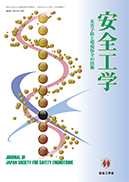All issues

Volume 52 (2013)
- Issue 6 Pages 01-
- Issue 5 Pages 01-
- Issue 4 Pages 01-
- Issue 3 Pages 01-
- Issue 2 Pages 01-
- Issue 1 Pages 01-
Volume 52, Issue 1
JOURNAL OF JAPAN SOCIETY FOR SAFETY ENGINEERING_2013_1
Displaying 1-13 of 13 articles from this issue
- |<
- <
- 1
- >
- >|
-
2013Volume 52Issue 1 Pages 01-04
Published: February 15, 2013
Released on J-STAGE: July 30, 2016
JOURNAL OPEN ACCESSDownload PDF (268K)
PROPOSAL FOR SAFETY
-
Mizuki Yamaguma2013Volume 52Issue 1 Pages 1
Published: February 15, 2013
Released on J-STAGE: July 30, 2016
JOURNAL OPEN ACCESSDownload PDF (203K)
REVIEW
-
-From Earthquake Damage Investigation for Iwaki Factory of Kureha Corporation-Hiroyuki Oba, Keisuke Matsukawa, Yuji Wada, Gen Ookubo, Nobuo Takagi2013Volume 52Issue 1 Pages 2-10
Published: February 15, 2013
Released on J-STAGE: July 30, 2016
JOURNAL OPEN ACCESS -
Masahiro Oguchi, Hidetaka Takigami, Kazuto Endo and Masahiro Osako2013Volume 52Issue 1 Pages 11-18
Published: February 15, 2013
Released on J-STAGE: July 30, 2016
JOURNAL OPEN ACCESS -
Kazuhiko Kato2013Volume 52Issue 1 Pages 19-25
Published: February 15, 2013
Released on J-STAGE: July 30, 2016
JOURNAL OPEN ACCESS
ORIGINAL PAPER
-
Toshiaki Fujihara and Toshiaki Kurose, Yukihiro Nedu, Yoshinobu Takaha ...2013Volume 52Issue 1 Pages 26-33
Published: February 15, 2013
Released on J-STAGE: July 30, 2016
JOURNAL OPEN ACCESSWhen a product involving a substantial hazard to consumers or property becomes apparent, a business operator needs to prevent sequential accidents. Many business operators might decide to voluntarily recall the product in the market. To assist the decision, a quantitative method based on the use of R-Map has been proposed by the Ministry of Economy, Trade and Industry in Japan. The R-Map, a risk assessment method, has two criteria. One is the possibility of a hazardous accident; the other is the severity of health/safety damage. A method of modifying the R-Map decision by combining these obvious criteria with some qualitative circumstances has been developed. This hybrid assessment procedure is often called a risk bias method, which aims to realize more appropriate decisions in line with an acceptable level in society. Several risk biases have already been pointed out by previous research. In this research, we investigated several trends by analyzing recall cases in Japan. We successfully found some tendencies to encourage voluntary recalls. One of these appeared in accordance with legislative changes requiring business operators to endeavor to conduct recalls in 2007. Moreover, some types of product were recalled due to quality problems rather than safety problems. Then, we indicate that these tendencies are risk bias factors.View full abstractDownload PDF (889K) -
Ikuto Nishimura, Tomomi Imamura, Toshio Mogi and Ritsu Dobashi2013Volume 52Issue 1 Pages 34-40
Published: February 15, 2013
Released on J-STAGE: July 30, 2016
JOURNAL OPEN ACCESSGas explosion in confined spaces generates a sudden rise of internal pressure and can result in extensive damage such as destruction of the structure, generation of blast waves, fragment scattering, and heat release. Predicting pressure behavior is necessary for risk assessment and safety management at places, such as chemical plants, where combustible materials are used. In the past, many explosion experiments have been performed and the data such as pressure histories and KG values have been obtained. However, in those experiments, less than tens of liters vessels were used and their volume were very small compared to real cases. It will cause underestimation of the risk to full-scale explosions because the effect of flame instabilities is neglected in small scale experiments. In fact, some studies showed that the flame accelerates in large scale because of instabilities of the flame front. In order to prevent the underestimation of the risk for gas explosions, the effect of flame front instabilities has to be considered. In this study, we considered the effect of the flame front instabilities by regarding the flame front as a fractal structure and proposed a new method which could predict the pressure behavior properly even in a large scale. We verified the accuracy of the new method by experiment. In addition, the correction of the KG value in a large vessel was proposed.View full abstractDownload PDF (1371K)
TECHNICAL REPORT
-
Haruhiko Itagaki2013Volume 52Issue 1 Pages 41-44
Published: February 15, 2013
Released on J-STAGE: July 30, 2016
JOURNAL OPEN ACCESS -
Takeshi Kikuchi2013Volume 52Issue 1 Pages 45-52
Published: February 15, 2013
Released on J-STAGE: July 30, 2016
JOURNAL OPEN ACCESS
SAFETY MANAGEMENT AND PROVISIONS IN THE CORPORATION
-
Akio Kobayashi2013Volume 52Issue 1 Pages 53-58
Published: February 15, 2013
Released on J-STAGE: July 30, 2016
JOURNAL OPEN ACCESSDownload PDF (1785K)
ACADEMIC ACTIVITIES
-
Koji Nishikawa2013Volume 52Issue 1 Pages 59-60
Published: February 15, 2013
Released on J-STAGE: July 30, 2016
JOURNAL OPEN ACCESSDownload PDF (876K)
-
[in Japanese]2013Volume 52Issue 1 Pages 61-65
Published: February 15, 2013
Released on J-STAGE: July 30, 2016
JOURNAL OPEN ACCESSDownload PDF (301K)
-
2013Volume 52Issue 1 Pages 66
Published: February 15, 2013
Released on J-STAGE: July 30, 2016
JOURNAL OPEN ACCESSDownload PDF (130K)
- |<
- <
- 1
- >
- >|